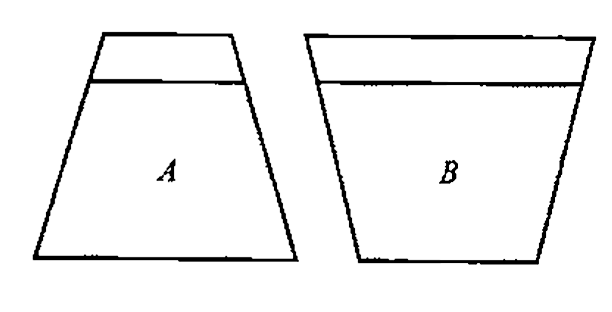Apparent expansion of a liquid depends upon
a) nature of liquid
b) nature of vessel
c) temperature rise
d) scale of temperatureSolution in Telugu
only (a) is true
(a) & (b) are true
(a), (b) & ( c) are true
(a), (b), ( c) & (d) are true
The correct Answer is:D
Step by step video, text & image solution for Apparent expansion of a liquid depends upon a) nature of liquid b) nature of vessel c) temperature rise d) scale of temperature by Physics experts to help you in doubts & scoring excellent marks in Class 11 exams.
Updated on:21/07/2023Topper's Solved these Questions
- THERMAL PROPERTIES OF MATTERBOOK - AAKASH SERIESCHAPTER - THERMAL PROPERTIES OF MATTEREXERCISE - EXERCISE-IB
68 Videos
- THERMAL PROPERTIES OF MATTERBOOK - AAKASH SERIESCHAPTER - THERMAL PROPERTIES OF MATTEREXERCISE - EXERCISE-2
106 Videos
- THERMAL PROPERTIES OF MATTERBOOK - AAKASH SERIESCHAPTER - THERMAL PROPERTIES OF MATTEREXERCISE - ADDITIONAL PRACTICE EXERCISE (LEVEL - II) PRACTICE SHEET (ADVANCED) Integer/Subjective Type Questions
2 Videos
- SYSTEM OF PARTICLES AND ROTATIONAL MOTIONBOOK - AAKASH SERIESCHAPTER - SYSTEM OF PARTICLES AND ROTATIONAL MOTIONEXERCISE - PRACTICE EXERCISE
99 Videos
- THERMODYNAMICSBOOK - AAKASH SERIESCHAPTER - THERMODYNAMICSEXERCISE - EXERCISE - 3
33 Videos
Similar Questions
(A) : Metals are isotropic solids
( R) : Metals are composed of large number of minute crystals which are randomly oriented resulting in isotropy
View SolutionExpress Ok on Fahrenheit scale.
View SolutionA constant pressure gas thermometer has a volume of 200cc, 273.2cc and 525 .1cc at 0°C, 100°C and boiling point of sulphur respectively. The resistance possessed by a platinum wire at the same temperatures as above are 2.000Ω,2.778Ωand5.280Ω respectively. Estimate the boiling point of sulphur on the basis of the two sets of observations.
View SolutionThe centre of mass of two particles with masses 2kg and 6 kg located at (1,1,1), (2,2,1) respectively has the coordinates
View SolutionA bullet of mass 10×10−3 moving with a speed of 20ms−1 hits an ice block (0∘C) of 990g kept at rest on a frictionless floor and gets embedded in it. If ice takes 50% of K.E, the amount of ice melted (in grams) approximately is (J=4.2J/cal) (latent heat of ice=80cal/g)
View SolutionIdentify the correct statements from the following:
(a) The apparent expansion of liquid depends the expansion of material of the container
(b) The real expansion of the liquids depends on the density of the liquid.
(c) The expansion of liquid with respect to the container is called the apparent expansion
View SolutionCoefficient of apparent expansions of a liquid in two different vessels are a and b. Then the real coefficient of expansions of liquids, if the ratio of volume expansion of vessel of x:y
View SolutionTwo vessels A and B of cross sections as shown contain a liquid up to the same height. As the temperature rises, the liquid pressure at the bottom (neglecting expansion of the vessels ) will :

View SolutionA vessel of volume 'V' is half filled with liquid of density '2d' and coefficient of apparent expansion 'X'. Other half of vessel is filled with another liquid of density 'd' and coefficient of apparent expansion '2x'. If temperature is increased by 4°C, mass of liquid expelled is -A) 3Vxd -B) B 6Vxd C) 9Vxd
View SolutionReal expansion of a liquid is equal to the difference between apparent expansion and expansion of vessel
View SolutionHow many of the following effect the vapour pressure developed in a container ?
View SolutionApparent expansion of liquid does not depend on
View SolutionCoefficient of real expansion of a liquid is 0.000182/∘C. If coefficient of linear expansion of vessel is 0.000009/∘C, coefficient of apparent expansion of the liquid is
View SolutionWhen the temperature of a liquid is raised by 100^(@)C, 0.01% of the liquid is expelled. Calculate the coefficient of apparent expansion of the liquid.
View SolutionA vessel of volume 'V' is half filled with a liquid of density '2d' and coefficient of apparent expansion 'x' and the other half is filled with another liquid of density 'd' but coefficient of apparent expansion '2x'. The temperature is raised through 2∘C, the mass of the liquid expelled out
View Solution
